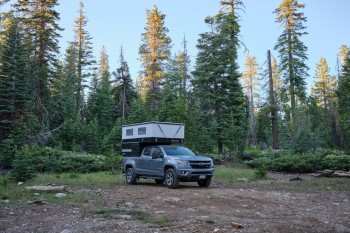Camping & Cabins
- Overnight accommodations are provided at more than 40 developed campgrounds and three cabins in the George Washington and Jefferson National Forests.
- Choose from a wide range of outdoor settings and levels of development. Some campgrounds are highly developed with large, level campsites, tables, fire rings, electricity, and bathhouses. Other campgrounds are more primitive with minimal site amenities.
- All campgrounds with single family campsites, including equestrian camps, offer sites on a first come, first served basis; and a number of those campgrounds also have some campsites on a reservation system. Groups looking for a place to camp have a number of choices. Most group campsites do require a reservation, including one group equestrian camp. Reservations can be made at www.recreation.gov or by calling (877) 444-6777.
- Camping stay is limited to 14 consecutive days in FS operated campgrounds and 28 consecutive days at concessionaire operated campgrounds.
- In campgrounds, camp only in those places specifically marked or provided.
- At least one person must occupy a camping area during the first night after camping equipment has been set up, unless permission has otherwise been granted by a forest ranger.
- Do not leave camping equipment unattended for more than 24 hours without permission from a forest ranger.
- The federal government is not responsible for any loss or damage to personal property.
- Remove all personal property and trash when leaving.
Dispersed Camping
Dispersed camping is a unique alternative recreation experience that is renewing, restorative and free of noise and congestion. Recreationist can camp anywhere in the National Forest outside a designated campground. Expect little to no facilities, restrooms, trash removal, fire pits and picnic tables.
This type of camping experience requires an additional layer of responsibilities including knowing the rules and regulations. To keep your experience safe and enjoyable; natural resources free from impacts, and unspoiled for other campers, know before you go!
- Groups of over 75 people will need a special use permit. Permits can be obtained at the nearest District Office.
- Be aware of forest boundaries intersecting and bordering on private land. Do not trespass.
- No amenities are provided; such as water, restrooms or trash cans. Be self-contained.
- Dispersed camping in one location is allowable up to 14 days in any 30-day period.
- Camp at least 100 feet from any stream or other water source.
- Follow Leave No Trace guidelines, pack it in, pack it out.
- Contact the local Forest Service office to see if any restrictions apply especially fire.
- Be Bear Aware. There are bears on the National Forest, so camp accordingly.
Dispersed camping is not allowed in the vicinity of developed recreation areas such as campgrounds, picnic areas, or trailheads. Many sites can be found along Forest Service roads with existing clearings. Drive on existing roads and avoid camping on undisturbed land. Keep your campsite within 150 feet from a roadway.
Pick a site that has been previously used. Plants, soil and wildlife are impacted by new campsites. Selecting existing sites minimizes impacts to the forest floor. If there is no existing campsite, then follow Leave No Trace Principles.
- If at all possible, camp on bare soil to avoid killing and damaging plants and grass.
- Do NOT camp within 100 feet of any water source. Plants near bodies of water are especially fragile.
- Do not camp in the middle of a clearing or meadow; try to make your campsite less visible so that other visitors will see a "wild" setting.
- Do not try to level or dig trenches in the ground at your campsite. Pick a tent site that is already level with good drainage.
Campfires are allowed but please use existing sites with fire rings. Be aware of fire restrictions before you start camping. Wood permits are not necessary for firewood collection. Ensure you have ample water and a fire extinguisher to extinguish your fire.
Tips for Safe, Low Impact Campfires:
- Minimize the scarring of new rocks, soil, and plants by using existing fire rings.
- Select a site that is not in a meadow or clearing, that is not next to a tree with low overhanging branches and is at least 100 feet from any water source.
- Clean an area and make a ring of rocks about two feet in diameter.
- Collect only dead wood that is on the ground. You should not cut branches from live trees.
- Before you leave your campfire make sure is it completely out. You should be able to put your whole hand into the ashes without being burned, and be cool to the touch. Stir the ashes to make sure all embers have cooled. Many forest fires are caused by abandoned campfires that were not completely out.
The impacts from improper disposal of human waste will contaminate water and cause impacts to the environment and cause illness.
Where Do I GO?
- Find a private spot that is 200 feet away from the trail, campsite, or any water source.
- Look for rich, dark soil, which will be higher in bacteria that can break down your feces more quickly.
- Try to find an area with soil that is soft to make digging a cathole a lot easier.
- Dig a six-inch hole and bury your feces completely.
- Look for and avoid runoff paths that could potentially contaminate water sources.
- Store used toilet paper in a plastic bag until you find a trash can to dispose.
For more detailed information on disposing of human waste in the forest, check out Leave No Trace.
Treating Your Water
Always assume that the water you collect is unsafe. That means heating it until it comes to a rolling boil, use water purification tablets or a water purification filter (not effective against all pathogens).









